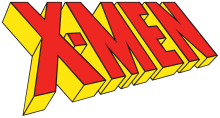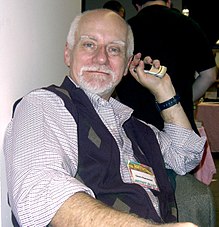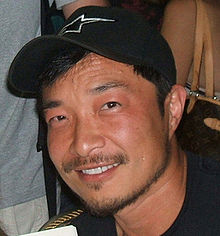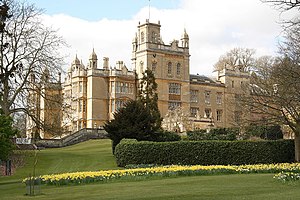X-Men
![]()
The title of this article is ambiguous. For other meanings, see X-Men (disambiguation).
The X-Men [ˈɛksmen] are a group of superheroes who appear in comic books published by Marvel. The X-Men were created by Stan Lee and Jack Kirby and first appeared in X-Men #1 (September 1963). The original version of the team failed to achieve much commercial success, despite the work of comic book greats such as Roy Thomas and Neal Adams. In 1975, the X-Men were reinterpreted by Dave Cockrum, Len Wein, and Chris Claremont. The All New All Different X-Men soon found its audience and became the most successful American comic book series of the 1980s and 1990s. The success of the first series led to the launch of numerous spin-off series, which were variously well received by audiences.
Since the early 1990s, the X-Men have also found their way into other media. In addition to animated series and video games, twelve Hollywood films have been released to date.
The X-Men form a group in the world of mutants - humans who possess superhuman abilities thanks to their special genetic code. Mutants are often hated by normal humans, whether out of fanaticism or fear that they might subjugate humanity or even replace it as the dominant species. This fear is fed by various mutants who use their powers for their own ends or hate humans. To protect the human environment from these malevolent mutants, Charles Francis Xavier (Professor X) has formed the X-Men group. The X-Men's arch enemy is the supervillain Magneto.
This constellation shows the socio-political undertones of the series: Mutants are often seen as a metaphor for oppressed minorities. Xavier is often compared to African-American civil rights activist Martin Luther King Jr, Magneto to the more militant Malcolm X.

Logo of the comic series X-Men
History
1960s
In September 1963, The X-Men #1 was published by writer Stan Lee and co-writer and cartoonist Jack Kirby. Under the guise of a "school for the gifted young," paraplegic telepath Charles Francis Xavier (Professor X) trains five mutant teenagers in Westchester County, New York, to use their superpowers: Cyclops (Scott Summers, uncontrolled eye-rays), the winged Angel (Warren Worthington III), the ape-like but highly intelligent Beast (Hank McCoy), Iceman (Bobby Drake, ice powers), and Marvel Girl (Jean Grey), a telekinetic and telepath. Initially, they all wear the same blue and gold uniform with mask, and it was established that they all contained a so-called X-factor in their genetic makeup that was responsible for their superpowers. According to Stan Lee, this was an excuse to avoid having to come up with a new backstory for each character. The X-Men's arch-nemesis, the racist and magnetic-powered Magneto, also appeared back in The X-Men #1. The X-Men #4 featured Magneto's team, a terrorist group called the Brotherhood of Evil Mutants. In addition, Lee initially planned for Magneto to be Professor X's brother, but this was never fleshed out.
A possible precursor to the concept of a school for mutants had appeared in the 1953 science fiction novel Children of the Atom by Wilmar Shiras. The main characters of this novel were children who were the unintended result of an experiment with genetic mutation. The term "Children of the Atom" has often been used in connection with the X-Men (including in the video game X-Men: Children of the Atom or in a miniseries of the same name by Joe Casey), but no concrete connection has ever been established.
The X-Men #14 introduced the Sentinels, mutant-hunting battle robots owned by the sinister scientist Bolivar Trask, who appeared frequently in subsequent comics and later in the film X-Men: Future is the Past, among others. After Lee and Kirby left the series in 1966, it was taken over by Roy Thomas and Werner Roth. Soon, the name of the series was expanded to Uncanny X-Men. In the late 1960s, Jim Steranko and Neal Adams came in to beef up the moderately-running series. They introduced new mutants, including Banshee (Sean Cassidy; superpowers: sonic screams), Havok (Alex Summers, Scott Summers' brother; plasma powers), and Polaris (Lorna Dane; magnetic powers). Although sales increased, Marvel initially stopped producing new X-Men stories with issue #66. By #93, the issues were filled with reprints of old stories. The only new appearances of the X-Men were guest spots in other Marvel series, including Avengers and Fantastic Four.
1970s
In the early years of the 1970s, sales of the X-Men comics remained low until writer Len Wein revamped the team in 1975's Giant Size X-Men #1, introducing new mutants who hailed from all over the world, some of whom were much older than the original X-Men: the devil-like but deeply religious German teleporter Nightcrawler (Kurt Wagner). the devil-like but deeply religious German teleporter Nightcrawler (Kurt Wagner), the Soviet Union-born metal man Colossus (Piotr Rasputin), and the Kenyan-born weather witch Storm (Ororo Munroe). They reintroduced the Canadian-born Wolverine (initially "Logan", later: James Howlett), who had previously been a minor character in the Marvel series Hulk. Wolverine established himself as the most popular X-Man and one of the most popular North American comic book heroes ever. When Wein left the comic to become a full-time writer, his successor Chris Claremont added Scottish mutant expert Dr. Moira MacTaggert and Lilandra, the queen of the alien Shi'ar, who becomes Xavier's lover. Claremont, who had a soft spot for strong, independent women, wrote many stories with fellow writer John Byrne featuring female heroes like Marvel Girl and Storm saving the world. One example is the Phoenix Saga (1976-7), in which Marvel Girl seemingly sacrifices herself to save her colleagues, but is reborn as the powerful Phoenix.
Claremont himself commented in 2013 that he thought the X-Men were "just cool" from the beginning and particularly enjoyed fleshing out their personal lives. He also preferred longer storylines with lots of hidden hints that he could spontaneously draw on in the course of later issues.
1980s
Claremont's peak came in the Dark Phoenix Saga (1980), in which he has Jean Grey/Phoenix kidnapped by the villainous Hellfire Club, who wants to make her his tool. Jean becomes an insane Dark Phoenix, acquires Satan-like powers, and destroys an inhabited solar system before she regains her senses. When Lilandra reluctantly has her judged as a mass murderer, she willingly goes to her death. This story, on which the movie X-Men 3 is essentially based, has often been voted one of the best Marvel stories. The Hellfire Club and Jean Grey's transformation into a black-clad vamp was an homage to the episode A Touch of Brimstone from the TV series With Umbrella, Charm and Bowler Hat, in which Emma Peel (Diana Rigg) dresses as a Dominatrix for cover. The Hellfire villains Sebastian Shaw, Harry Leland, Donald Pierce, Jason Wyngarde were pastiches of actors Robert Shaw, Orson Welles, Donald Sutherland as well as Peter Wyngarde. He also introduced their scantily clad, telepathically gifted shearer Emma Frost, who saw her provocative outfit not as a sign of submission but to control easily manipulated men.
After Jean Grey's passing, Claremont continued to rely on strong female personalities. He made Storm the leader of the X-Men in 1980, making them one of the first comic book groups with a female leader. He then focused on the next female X-Man, the US Jewish Shadowcat (Kitty Pryde, can walk through walls): in Days of Future Past (1981, later formed the basis for the X-Men movie X-Men: Future is Past), her ghost escapes a dystopian future where the Sentinels have wiped out almost all the mutants, and gets her younger self to stop an attack by the mutant terrorist Mystique. In Kitty Pryde and Wolverine (1984-5), she saves her father from the Yakuza. During this time, Claremont elaborated on the tragic backstory of Magneto, who was portrayed as a Holocaust survivor, reconciled with the X-Men, and even became their leader after Charles Xavier's temporary departure. Also defecting was the one-time Brotherhood terrorist Rogue, who can steal powers from other mutants by touch, and from the Marvel series Captain Britain came Brit Psylocke (Betsy Braddock), who was later transformed into a Japanese psi-ninja through bionic manipulation. Another notable story was God Loves, Man Kills (1982) about the rise and fall of mutant-hating priest William Stryker, which later formed the basis for the film X-Men 2. Other characters introduced during this decade included the sinister geneticist Mr. Sinister, who created Jean Grey's clone named Madelyne Pryor, the cheeky Asian mutant Jubilee (Jubilation Lee; Fireworks Forces), the mutant rebel Longshot, and the terrorist group Reavers. During the crossover Fall of the Mutants (1988), the X-Men seemingly died but were actually shipped to Australia.
This decade saw the release of the first spin-offs of the X-Men series, including Wolverine, the stand-alone series of the eponymous character; New Mutants, which introduced new, younger mutants; Alpha Flight and Excalibur, which introduced Canadian and British mutant teams respectively; and X-Factor, which focused on the original X-Men team of the 1960s. Here, writer Kurt Busiek pulled off an artifice in 1986: in order to reintroduce Jean Grey, who had died as a mass murderer in the Dark Phoenix saga, he established that since the first Phoenix saga (1976-7), it was not Jean who had been acting, but an energy being called the Phoenix Force, which looked deceptively like her. The real Jean had been in a coma from which she was now awakening. This resurrection was viewed critically by Chris Claremont and others.
1990s
In 1991, Claremont's 16-year writing tenure on Uncanny X-Men came to an end, and younger artists like Fabian Nicieza, Rob Liefeld, and Jim Lee took the helm. They primarily introduced antiheroes like the heavily armed mercenary Cable, the gentleman thief Gambit, and the wisecracking Deadpool, who went on to become one of the most popular characters in recent Marvel history. Liefeld turned the New Mutants into the paramilitary strike force X-Force, led by the mysterious mutant Cable. Lee and Liefeld's popularity led to X-Men #1 (Vol. 2) and X-Force #1 becoming the most successful superhero comics to date. This was partly due to the fact that, at the time, speculators were banking on being able to make money from comics and therefore bought several of the same issues of a series (→ comics speculation bubble). X-Men #1 (Vol. 2) resulted in sales of seven million US dollars, earning it an entry in the Guinness Book of Records for the highest-selling single comic book. During this time, the fan and critically popular cartoon series X-Men aired, running for five seasons totaling 76 episodes beginning in 1992. An important storyline from an LGBT perspective was written that year in Alpha Flight #106, in which a French Canadian mutant named Jean-Paul Beaubier (Northstar) came out as gay. Also in 1992, a bang occurred when Liefeld, Nicieza, Lee, and many younger artists collectively left Marvel Comics to form the rival publisher Image Comics. In the years that followed, X-Men comics saw a number of lengthy storylines spanning many X-Men series, such as X-Tinction Agenda (1990), The X-Cutioners Song (1992), Phalanx Covenant (1994), Age of Apocalypse (1995), Onslaught (1996), and Operation Zero Tolerance (1997), which critics described as action-packed but often chaotic.
In the mid-1990s, after the comic book boom ended, several more X spin-off series were launched, including Generation X, X-Man, and other solo series of well-known mutants such as Cable, Gambit, Bishop, and Deadpool. In 1998, Excalibur was cancelled and X-Factor was replaced by Mutant X, which told the adventures of Havok in an alternate reality.
2000s
In the new millennium, the image of the X-Men was largely defined by the X-Men film series, which starred Oscar winners Halle Berry as Storm and Anna Paquin as Rogue, and Oscar nominee Ian McKellen as Magneto, among others. Hugh Jackman consistently garnered much praise for his interpretation of Wolverine. The first film X-Men (2000) was the first ever Marvel box office success and paved the way for later Marvel film series. In the comics, Marvel introduced reinterpretations of the X-Men in an alternate universe called Ultimate X-Men by writer Mark Millar to attract new fans without having to bring four decades of prior knowledge. In this hipper version, for example, Storm was from Harlem, Colossus was gay, and Magneto was responsible for Charles Xavier's paraplegia. The original X-Men comics, on the other hand, were dominated by stories that focused on the fate of mutants as a social group (Riot at Xavier's, House of M, Gifted, Endangered Species, etc.) by writer Grant Morrison, among others. In addition, longtime X-Men antagonist Emma Frost switched sides, and many veteran characters such as Jean Grey, Colossus, Moira MacTaggert, and Psylocke were killed off before being written back into the comics (mostly). Writer Joss Whedon, who wrote Gifted, penned various stories centered on his favorite character, Kitty Pryde: Kitty was once the inspiration for his Buffy series, and a Buffy storyline in which main character Willow loses her mind due to the death of a loved one and becomes the Satan-like Dark Willow was inspired by the Dark Phoenix saga. Whedon even wanted to imply that Buffy protagonist Buffy Summers and longtime X-Men leader Scott Summers were related, this was ultimately not carried out.
In addition to the films, the decade also saw two X-Men animated series, X-Men: It Continues (2000-2003, 52 episodes total) and Wolverine and the X-Men (2009, 26 episodes total). X-Men: It Continues were teenage versions of the X-Men and their adversaries, combining their adventures with plenty of school comedy, while Wolverine and the X-Men stuck closely to the darker mood of the original comics.
Many smaller X-Men series such as Mutant X, Generation X as well as many solo series were discontinued and replaced a short time later by solo series of mainly female mutants (Rogue, Mystique, Jubilee, etc.) as well as by special interest series in which, among other things, dubious (Weapon X), traveling between parallel worlds (Exiles) or sponsored X-Men (X-Force, later X-Statix) were the focus.
2010s
The beginning of the decade was marked by Marvel NOW! in which, among other things, the X-Men received a relaunch. Here, the X-Men met their younger versions as well as their counterparts from the Ultimate X-Men comics, among others. The comic Astonishing X-Men #51 (2012), in which the homosexual X-Man Northstar married his fiancé Kyle, three years before same-sex marriage was introduced in the United States, caused a stir. In addition, a second X-Men film series was launched: Again, notable actors were signed on, including Academy Award winner Jennifer Lawrence (Mystique), Golden Globe winner Peter Dinklage (Bolivar Trask) and Academy Award nominee Michael Fassbender (Magneto).

Chris Claremont wrote X-Men stories with strong female characters for 16 years.

Jim Lee drew the highest-grossing single comic to date with X-Men #1 (Vol. 2) (1992).
.jpg)
In 2012, X-Men co-inventor Stan Lee (center, uncostumed) posed with cosplayers depicting X-Men characters Juggernaut and Sabretooth (left) and Wolverine, Gambit and Storm (right), among others.
.jpg)
Cosplayers of the original X-Men from 1963 in their blue and gold masked uniforms. From left to right: Iceman, Beast, Professor X (seated), Angel, Cyclops, Marvel Girl.
The World of the X-Men
Xavier's School
Since the 1960s, it has been established in the Marvel Universe that the X-Men live in the X-Mansion (X-Mansion) in Westchester County, New York, which is officially named Xavier's School for Gifted Youngsters and has "mutatis mutandis" as its school motto. The school is the former mansion of Charles Xavier's parents, which he inherited after their deaths and converted into a boarding school for gifted youngsters. He had laboratories and training rooms set up underneath the building, spread over several floors. The X-Men train in the so-called Danger Room, which was initially introduced as a room full of traps and guns, until it was developed into a holographic simulation in later versions. The X-Men usually fly to their missions in the Blackbird, a modified Lockheed SR-71 whose hangar is located under the basketball court on the grounds.
Cerebro
In the underground complex beneath Xavier's school is Cerebro, a facility that allows telepathically gifted mutants like Prof. Xavier to locate the brainwaves of all humans and mutants around the world and thus connect with them. Cerebro is a spherical hall with a walkway leading from the entrance to the center of the hall. There is an armchair and the control computer, to which the telepath connects by means of a special headgear. The inside of the hall is lined with special panels that are crucial to the way Cerebro works. Cerebro was originally developed by Xavier and Magneto, and later enhanced by Dr. Hank McCoy. Cerebro is mainly used by Prof. Xavier, Jean Grey, Emma Frost.
Fictional places
- Asteroid M, an asteroid created by Magneto and temporarily his headquarters.
- Genosha, an island near Madagascar and for a long time an apartheid regime against mutants
- Madripur, an island near Singapore where corruption and smuggling flourish
- Muir Island, an island off Scotland, laboratory of Moira MacTaggert
- Mutant Town, a run-down mutant ghetto in Manhattan...
- Savage Land, a primeval paradise full of dinosaurs hidden in Antarctica.

Englefield House in Berkshire, England served as the X-Mansion in the film X-Men: First Decision.
Questions and Answers
Q: Who are the X-Men?
A: The X-Men are a team of superheroes who were born with special mutant powers, making them different from regular humans.
Q: Who owns the X-Men characters?
A: The X-Men characters are owned by Marvel Comics, which publishes comic books featuring them as well as many other superheroes.
Q: What was unique about the X-Men comic book?
A: The comic book was one of the first to combine social issues and social commentary into a superhero story, set in a world where people with mutant abilities are hated by those born without them.
Q: What is ableism?
A: Ableism is a type of discrimination against people with disabilities or people who are perceived to have disabilities.
Q: Do all mutants behave like the X-Men?
A: No, unlike "some" mutants, the X-Men try to be good and show tolerance toward humans and other mutants.
Q: Who inspired the idea behind the X-Men superheroes?
A: The idea behind the superheroes were inspired by the African-American equality supporters like Malcolm X and Martin Luther King.
Q: What issue is highlighted in the X-Men comic book?
A: The X-Men comic book highlights the issue of discrimination against people with mutant abilities.
Search within the encyclopedia